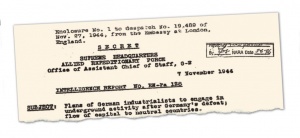Red House meeting
 A document of unknown authenticity. | |
| Date | August 10, 1944 |
|---|---|
| Type | • secret • |
| Interest of | Hermann Abs, Dave Emory, Adam LeBor |
| Description | A purported meeting of an elite group of German industrialists to plan for Germany's post-war recovery, preparing for the Nazis' return to power and work for a "strong German empire". |
The Red House meeting, as referenced in US Military Intelligence report EW-Pa 128, occurred on 7 November 1944 in Strasbourg, France.
Contents
Official Narrative
This meeting doesn't figure in official histories of World War II. Since 2012, English Wikipedia links from "The Red House Report" to the author Adam LeBor, who cites it is inspiration for his work of fiction, "The Budapest Protocol". The implication is that no such meeting ever occurred. As of December 2017, French Wikipedia had a separate page, although it was suggested to be a "conspiracy theory".[1]
"Red House Report"

This secret meeting is only known to exist as a result of the "Red House Report", which author Adam LeBor claims was written by a French spy who was at the meeting. He claims to have "unearthed from US intelligence files"[2] a closely typed 3 page summary of the discussion carried out on August 10, 1944, sent to British officials and thence by air pouch to Cordell Hull, the US Secretary of State. He has not however provided a chain of custody for this document or submitted it to experts for analysis.
It is documented here because if it is genuine, the implications are immense. The text of "US Military Intelligence report EW-Pa 128" is however available, which should provide some with a chance to investigate its authenticity...[3]
Schedule
Morning Conference
The main conference was held in the morning.
Afternoon Conference
A smaller conference in the afternoon, presided over by Dr. Bosse of the German Armaments Ministry, was attended only by representatives of Hecko, Krupp, and Röchling. Dr. Bosse reiterated Bormann's belief that the war unwinnable, but that it would be sustained until certain goals to insure the later economic resurgence of Germany had been achieved. He reminded German industrialists that they must be prepared to finance the continuation of the Nazi Party, which would be forced to go underground, just as had the Maquis in France.
Policy reversal
Both conferences were reminded that Reichsleiter Martin Bormann had cancelled the 1933 Treason Against the Nation statue, which mandated the death penalty for violation of foreign exchange regulations or concealing of foreign currency, was a dead letter. Instead, the new Nazi policy was to export as much of value as possible, not only money and bonds but also patents, scientists, and administrators.
Related Documents
| Title | Type | Publication date | Author(s) | Description |
|---|---|---|---|---|
| Document:Princes of Plunder | article | 1999 | David Guyatt | Why, but for a suppressed act of treachery motivated by the safeguarding of vast wealth, the capture of the Arnhem bridge during the Allies' Operation 'Market Garden' might not have been 'A Bridge Too Far' |
| File:Martin Bormann - Nazi In Exile.pdf | book | 1981 | Paul Manning | A deep history of transnational corporate ownership networks originating from the fascist junction of state and economic power in Germany before and during WWII |